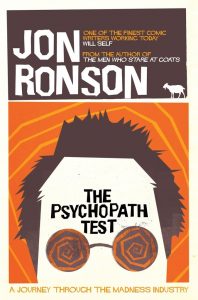The Psychopath Test by Jon Ronson, UK, 2011
Where does the line go between sanity, insanity and eccentricity? Is our concept of ‘normal’ constant, or does it fluctuate? Is it possible to draw up a list of characteristics that then labe l a person mentally deranged or a psychopath?
l a person mentally deranged or a psychopath?
 l a person mentally deranged or a psychopath?
l a person mentally deranged or a psychopath?In his book The Psychopath Test, Ronson begins by studying Robert Hare’s check list for psychopaths. “Superficial charm, Pathological lying, Lack of empathy. . . ‘
As he studies the twenty characteristics, he begins to fear that he is surrounded by psychopaths even though, statistically, they account for only 1% of the population (and yet they account for 3% of all managerial and power positions). His research takes him from the UK to USA to Sweden; from mental institutions, to gaols for the criminally insane to new-age healing centres. He interviews diagnosed psychopaths and he talks to psychiatrists – in the end he decides that diagnosing a person on the basis of a check list can be extremely dangerous. The list negates the person, and the person may simply be eccentric.
He touches on the terrifying over-diagnosing of children with ADD, autism and childhood bipolar disorder, and how the pharmaceutical companies are pushing the trend. The word ‘normal’ has been erased and psychiatrists seek to label (and then medicate) the naughty, tired, eccentric, innovative child. Ronson admits that there are children with mental problems, but they are in the minority.
The book is, as Ronson suggests, ‘a journey through the madness industry’. It is well written; there is humour and insight; and for a non-fiction book it is difficult to put down. Ronson presents his findings, and lets the reader make up his/her mind. I personally found it frightening from the perspective that there are obviously so many psychopaths in high places (and this could be an explanation for the sorry state of the world), but I also found it disconcerting that although psychiatrists are hell bent on diagnosing they do not always get it right.
A diagnosis of mental illness can be bad enough, but a wrong diagnosis can be life destroying.
Photo of Jon Ronson from TED.com
